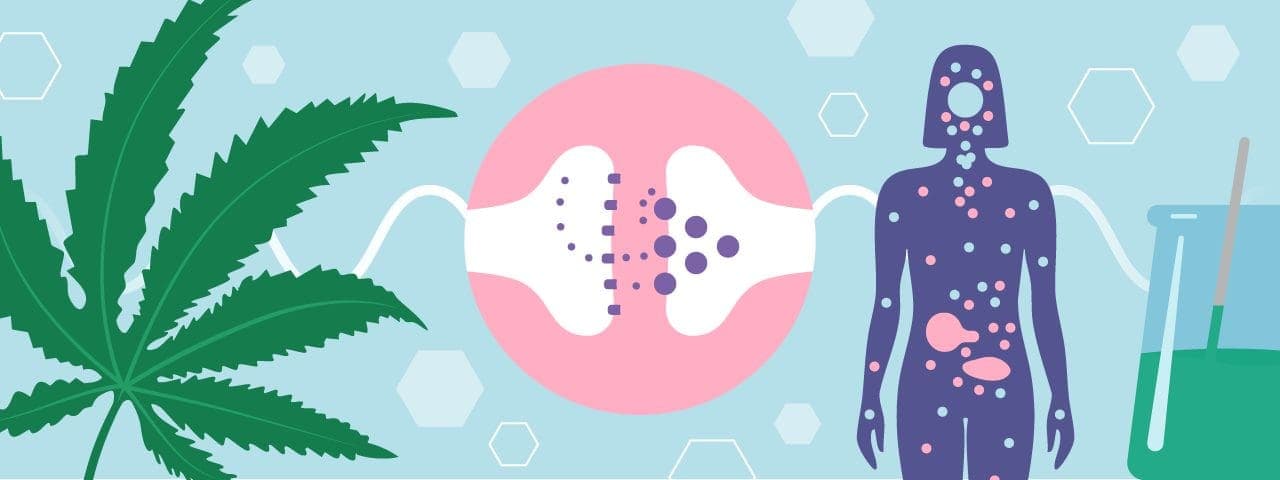What are cannabinoids, exactly?

Article written by

Olivia SwannWriter & Digital Marketing Specialist
Cannabinoids are compounds that interact with your body’s endocannabinoid system (ECS). The ECS is a network that helps regulate mood, sleep, appetite, and pain.
These interactions shape the way you experience cannabis, from the “high” associated with tetrahydrocannabinol (THC) to the calming effects of cannabidiol (CBD).
What are cannabinoids?
Cannabinoids are chemical messengers that bind to receptors in your body’s ECS.
The ECS works to maintain balance across many bodily processes. When cannabinoids interact with the ECS, they can influence both mental and physical health.
The ECS helps regulate:
- Mood and stress levels
- Sleep and circadian rhythm
- Appetite and digestion
- Memory and learning
- Immune system response
- Pain and inflammation
Types of cannabinoids
Scientists group cannabinoids into three main categories: endocannabinoids, phytocannabinoids, and synthetic cannabinoids.
Endocannabinoids
Endocannabinoids are cannabinoids made naturally in your body. They keep your ECS running smoothly.
Two key examples of endocannabinoids include:
- Anandamide: Often called the “bliss molecule,” anandamide influences mood, motivation, and response to sensory rewards
- 2-Arachidonoylglycerol (2-AG): Plays a role in promoting immune health and regulating inflammation
Phytocannabinoids
Phytocannabinoids are cannabinoids produced by cannabis and hemp plants.
These are the compounds most people think of when they talk about cannabis, as cannabis produces more than 150 cannabinoids.
Notably, some phytocannabinoids are psychoactive, while others are not. A substance is considered psychoactive if it affects mood, behavior, or subjective perception.
Common phytocannabinoids include:
- THC: Psychoactive; produces a “high”
- CBD: Non-intoxicating; used to help ease anxiety, seizures, and pain
- Cannabigerol (CBG): Non-intoxicating; used for antibacterial and neuroprotective properties
- Cannabichromene (CBC): Non-intoxicating; may help boost mood and reduce inflammation
- Tetrahydrocannabivarin (THCV): Psychoactive in high doses; may help suppress appetite and increase metabolism
Synthetic and semi-synthetic cannabinoids
Synthetic and semi-synthetic cannabinoids are compounds made in a laboratory. They’re designed to mimic the cannabinoids your body naturally makes.
Synthetic cannabinoids can be beneficial when regulated, but harmful when produced illegally.
Examples include:
- FDA-approved medications: Dronabinol (Marinol) and nabilone (Cesamet) are synthetic cannabinoid medications prescribed to treat chemotherapy-related nausea.
- Hemp-derived cannabinoids: These products are made by chemically converting natural hemp compounds — often CBD — into a new cannabinoid, like delta 8-THC or hexahydrocannabinol (HHC).
- Unregulated drugs: Unregulated synthetic cannabinoids, including “K2/Spice”, can be dangerous and cause severe side effects.
Always purchase your cannabis products from reputable licensed dispensaries or retailers that prioritize third-party lab testing.
How to use the cannabinoids in cannabis
The way in which cannabinoids interact with the ECS may help you manage a range of health conditions, including:
- Chronic pain
- Anxiety and depression
- Epilepsy and seizures
- Insomnia and sleep disorders
- Inflammation
- Nausea and vomiting
More research is needed to confirm the exact health benefits of cannabinoids in cannabis.
Currently, some of the strongest evidence supports using cannabinoids to help with pain, inflammation, seizures, nausea, and vomiting.
Emerging studies also suggest potential benefits for managing mood and sleep disorders, but those results are not yet proven.
Tips for using cannabinoids
When trying new products that contain cannabinoids, keep these best practices in mind:
- Check the cannabinoid content on product labels to ensure it contains what you’re looking for.
- Start low and go slow, especially with psychoactive cannabinoids like THC. This means starting with a low dose and slowly increasing it over time until you reach the desired effects.
- Ask your doctor if cannabis may interact with any medications you take.
- Choose lab-tested products for safety and accuracy.
Cannabinoids affect everyone differently based on factors like weight, metabolism, and tolerance.
Track how various cannabinoids affect you by keeping a journal and noting how you feel after using different strains and products.
The bottom line: Cannabinoid science is evolving
Cannabinoids are a diverse group of compounds that influence various bodily processes, from mood to pain perception.
By working with your endocannabinoid system, they can shape both your cannabis experience and your overall well-being.
While ongoing research continues to uncover their potential, responsible use under proper guidance remains key to maximizing the benefits of cannabinoids.
Resources
- Cannabinoid antiemetic therapy. https://www.ncbi.nlm.nih.gov/books/NBK535430/
- Cannabinoid treatments in epilepsy and seizure disorders. https://pubmed.ncbi.nlm.nih.gov/37882730/
- Cannabinoids. https://www.ncbi.nlm.nih.gov/books/NBK556062/
- Cannabinoids and sleep: Exploring biological mechanisms and therapeutic potentials. https://pmc.ncbi.nlm.nih.gov/articles/PMC11011314/
- Cannabinoids in chronic pain management: A review of the history, efficacy, applications, and risks. https://pubmed.ncbi.nlm.nih.gov/40149508/
- Cannabinoids, insomnia, and other sleep disorders. https://pubmed.ncbi.nlm.nih.gov/35537535/
- Endocannabinoid and dopaminergic system: the pas de deux underlying human motivation and behaviors. https://pmc.ncbi.nlm.nih.gov/articles/PMC8105194/
- Endocannabinoids and aging: Inflammation, neuroplasticity, mood and pain. https://pubmed.ncbi.nlm.nih.gov/33706946/
- Exploring the versatile roles of the endocannabinoid system and phytocannabinoids in modulating bacterial infections. https://journals.asm.org/doi/10.1128/iai.00020-24
- Hexahydrocannabinol and closely related semi-synthetic cannabinoids: A comprehensive review. https://pubmed.ncbi.nlm.nih.gov/37269160/
- Medical cannabis activity against inflammation: active compounds and modes of action. https://pubmed.ncbi.nlm.nih.gov/35614947/
- Phytocannabinoids: Exploring pharmacological profiles and their impact on therapeutical use. https://www.mdpi.com/1422-0067/25/8/4204
- Role of the endocannabinoid system in the regulation of intestinal homeostasis. https://pmc.ncbi.nlm.nih.gov/articles/PMC9500439/
- The endocannabinoid system in appetite regulation and treatment of obesity. https://pmc.ncbi.nlm.nih.gov/articles/PMC11409765/
- The role of endocannabinoids in physiological processes and disease pathology: A comprehensive review. https://pmc.ncbi.nlm.nih.gov/articles/PMC12027566/
- Therapeutic potential of cannabis: A comprehensive review of current and future applications. https://pmc.ncbi.nlm.nih.gov/articles/PMC10604755/
- Toxicity of synthetic cannabinoids in k2/spice: a systematic review. https://pubmed.ncbi.nlm.nih.gov/37508922/
Get your medical marijuana card
Frequently asked questions
Find answers to common questions about cannabinoids.


